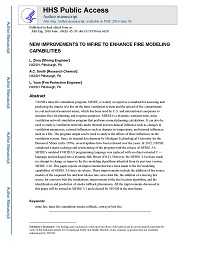Mining Publication: New Improvements to MFIRE to Enhance Fire Modeling Capabilities
Original creation date: June 2016
NIOSH's mine fire simulation program, MFIRE, is widely accepted as a standard for assessing and predicting the impact of a fire on the mine ventilation system and the spread of fire contaminants in coal and metal/nonmetal mines, which has been used by U.S. and international companies to simulate fires for planning and response purposes. MFIRE is a dynamic, transient-state, mine ventilation network simulation program that performs normal planning calculations. It can also be used to analyze ventilation networks under thermal and mechanical influence such as changes in ventilation parameters, external influences such as changes in temperature, and internal influences such as a fire. The program output can be used to analyze the effects of these influences on the ventilation system. Since its original development by Michigan Technological University for the Bureau of Mines in the 1970s, several updates have been released over the years. In 2012, NIOSH completed a major redesign and restructuring of the program with the release of MFIRE 3.0. MFIRE's outdated FORTRAN programming language was replaced with an object-oriented C++ language and packaged into a dynamic link library (DLL). However, the MFIRE 3.0 release made no attempt to change or improve the fire modeling algorithms inherited from its previous version, MFIRE 2.20. This paper reports on improvements that have been made to the fire modeling capabilities of MFIRE 3.0 since its release. These improvements include the addition of fire source models of the t-squared fire and heat release rate curve data file, the addition of a moving fire source for conveyor belt fire simulations, improvement of the fire location algorithm, and the identification and prediction of smoke rollback phenomena. All the improvements discussed in this paper will be termed as MFIRE 3.1 and released by NIOSH in the near future.
Authors: L Zhou, AC Smith, L Yuan
See Also
- The Critical Ventilation Velocity in Tunnel Fires - A Computer Simulation
- Development and Application of Reservoir Models and Artificial Neural Networks for Optimizing Ventilation Air Requirements in Development Mining of Coal Seams
- Experimental and Modeling Investigation of the Effect of Ventilation on Smoke Rollback in a Mine Entry
- MFIRE - 3.0.50
- MFIRE Users Manual Version 2.20
- Modeling and Prediction of Ventilation Methane Emissions of U.S. Longwall Mines Using Supervised Artificial Neural Networks
- Safety Aspects of Mine Ventilation Through Technical Development and Training
- Specialized Fortran Computer Programming and Analysis Services to Upgrade Capability of MFIRE Program
- Study of Mine Fires and Mine Ventilation: Part I, Computer Simulation of Ventilation Systems Under the Influence of Mine Fires
- Technology News 549 - MFIRE 3.0 - NIOSH Brings MFIRE into 21st Century
- Content source: National Institute for Occupational Safety and Health, Mining Program


 ShareCompartir
ShareCompartir
